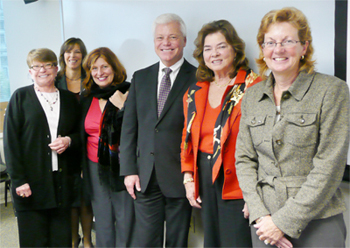FOUNDATION LEADERS DESCRIBE ELEMENTS OF GOOD GRANT PROPOSALSYour Part-Time Controller convened a panel of foundation executives during a recent staff training to speak to its staff about important issues affecting its clients. Many of Your Part-Time Controller’s nonprofit clients depend upon foundations for their general operations and/or specific projects. In order to better help its clients to secure this critical funding, the training featured a panel of foundation executives who provided an animated and spirited discussion about what makes a good grant proposal, what foundations look for in determining whether to award a grant, and how the economic downturn is affecting funding to the nonprofit sector. Participating foundations were the Chester County Community Foundation, The Connelly Foundation, The Independence Foundation, The Pew Charitable Trusts, and The Philadelphia Foundation.  Bia Vieira First, nonprofits must recognize that not all foundations are alike, and it is critical to “do your homework” and research the foundations you plan to apply to. “It’s a common saying in the world of philanthropy that if you know one foundation, you know one foundation,” said Bia Vieira, Vice President for Philanthropic Services for The Philadelphia Foundation.  Susan Sherman Even when you think you know the foundation, its priorities and initiatives can change. “Foundations are weird animals,” said Susan Sherman, President and CEO of The Independence Foundation, describing the challenges when foundations change their commitment to an initiative after several years, forcing grantees to seek other funders. “Do your homework, and make sure your application meets the foundation’s current priorities.”  Beth Briglia Each foundation has its own funding mechanism, is at its own stage of growth and development, and its donors have their own priorities, so applicants must understand the foundation’s situation, said Beth Briglia, Vice President for Donor Services and Grantmaking for the Chester County Community Foundation.  Greg Rowe That thought was echoed by Greg Rowe, Director of Culture Initiatives and Deputy Director of The Philadelphia Program for The Pew Charitable Trusts. “If you don’t meet the foundation’s needs, don’t bother applying.”Panelists discussed what they look for in a strong grant proposal. First and foremost is being clear about what you’re asking for and demonstrating that you have the competency to do the job.  Emily C. Riley “Clarity is numero uno,” said Emily C. Riley, Executive Vice President for The Connelly Foundation. A good application has sufficient description and specifics to convey that the nonprofit has the know-how to do what it promises. |
 Leaders from five Philadelphia-area foundations gather after the staff training with YPTC Partner Jennifer Alleva (rear). From left are: Susan Sherman of The Independence Foundation; Bia Vieira of The Philadelphia Foundation; Greg Rowe of The Pew Charitable Trusts; Emily C. Riley of The Connelly Foundation; and Beth Briglia of The Chester County Community Foundation. “Foundations like to see a really straight-up, honest proposal about what you want to do, how you’re going to do it, when you’re going to do it, and how you’ll know that you’ve gotten it done,” said Sherman. “We don’t want to see a lot of rhetoric. We don’t want to have to wade through two pages and still not know what you want.” Common pitfalls for grantseekers include inventing a program just because they think a foundation will fund it, and making simple mistakes that show a lack of attention. Sending out a “boilerplate” application with the wrong foundation’s name, having inaccurate financial data, and writing a proposal loaded with typographical errors are not good examples of a nonprofit’s capabilities. “Any grant proposal should have at least three outside readers,” said Sherman. Foundations like to see a strong balance sheet with honest projections. “If we’re going to make a three-year investment in you, we want to know that you’re planning for your future,” said Rowe. The capitalization of many nonprofits is troubling, and there’s an oversupply of many organizations. Foundations want to see that applicants know their niche in the marketplace, the community’s needs, and how many donors will actually support the program. “We’re looking at whether your projections make sense,” he said. A nonprofit’s financial statements tell a story and the organization should not be afraid to describe that story in more detail than a 990 might reveal. If you think a funder is going to ask a question about your financial statements, be prepared to answer it. The 990 forms have become an important tool in telling their story. “More donors are becoming astute and are checking out Charity Navigator and Guidestar, which get their information from the 990s. Donors may see their contribution as a charitable gift or as an investment but in either case they want to be informed,” said Briglia. Other things a foundation likes to see are data that they can rely on, passion, a good track record, that the grant will meet the needs of the community, and that the organization has the financial capacity to accomplish the task. “Understand your capacity,” advised Vieira. “We want to invest in your organization and make you stronger. We want our partnership with you to make sense.” Foundations do their homework, too, she said, and many foundations spend a lot of time with applicants before they apply to see if they fit in. Foundations may look at a nonprofit’s 990s, its budget deficits, three years of financial history, and may share information with other funders to gain insights. “Does the organization have the capacity to pull it off, or is the money going to disappear into a black hole?” asked Rowe. Local funders represent what several panelists noted is “a small community.” As Sherman said, “If one of us knows something’s wrong with a nonprofit, it gets shared immediately.” Foundations also stay on top of the nonprofit sector by gathering information. Many ask to be placed on their grantees’ mailing lists to keep up with organizational newsletters and developments. Many keep track of newspaper coverage about their grantees. “Funders don’t want to be surprised by picking up the newspaper and seeing that a nonprofit has gone out of business,” said Briglia. “We don’t want to be surprised at the end of a project,” said Vieira. “So be proactive and talk to us. Don’t spend money on something we didn’t agree to. You don’t want your funders to be surprised.” If problems emerge at the nonprofit, panelists agreed that the best course of action is to be honest and open with funders. “Candor is better,” said Rowe. “Put your context on anything bad before someone else can layer it with their context.” Even though all the candor in the world won’t guarantee that a problematic grant application will be funded, foundations appreciate the honesty and may look favorably on the nonprofit in the future. “It’s the organization that doesn’t communicate directly with us that gets into trouble,” said Sherman. Panelists described great variability in the degree to which foundations monitor grants. Some require periodic reports, while others choose to not second-guess a good organization in which they have invested grants for general operations. A common nonprofit pitfall is to be so focused on outcomes measurements that the rhetoric becomes what Sherman called “overkill. Sometimes you’re so crazy worrying about your outcomes you have nothing interesting going on.” Others noted the challenge of quantifying the metrics of a grant. Many foundation executives have worked for nonprofits themselves where they have written grant applications and manufactured outcomes measurements. Panelists agreed that impact is more important that outcomes – and equally challenging to measure. “We can certainly count noses, but that’s not necessarily a measure of how successful a program is or what the impact will be five years from now,” said Rowe. Outcomes may be significant for the nonprofit but if the foundation has a major initiative it may take years for the impact to become apparent. Foundations want to be able to tell their boards and donors that their money was used effectively. A key question, said Briglia, is, “Has the money we’ve given over the years helped the organization grow so they don’t need the funding?” Misdirected or unfulfilled grants can be rescinded. Grantmaking “is a competitive process,” said Rowe. “If you didn’t do something you said you’d do, that means someone else didn’t get a grant as a result.” Foundations, like nonprofits, have been affected by the recession. While most have seen their assets and grantmaking decline, others have had their donors contribute more to meet immediate needs. Many have diversified their portfolios to avert investment disasters. Others have tapped into reserve funds. Some have done strategic planning and narrowed their grantmaking focus. Some have given out unsolicited “recession grants” to help nonprofits weather the storm. Many are providing more support for social services agencies. Some have relaxed earlier requirements that a nonprofit could not show deficit spending in order to qualify for grants. Some have even questioned whether foundations should conserve their resources to survive in perpetuity or spend down their assets to address immediate needs. Meanwhile, grant cycles continue and foundations want to know that their investments in the community are being used wisely. “The hardest thing for organizations is getting the first dollar,” said Sherman. But once they do, “We want to see consistency, impact, and that there’s a story about what you’re doing,” said Vieira. |
What Makes a Great Grant Proposal?






